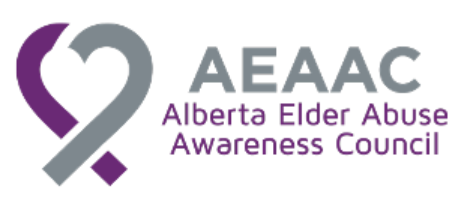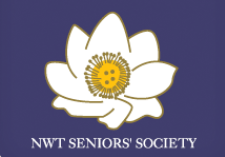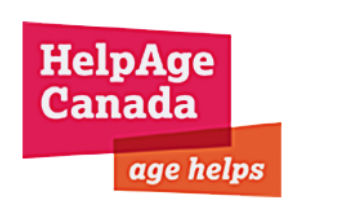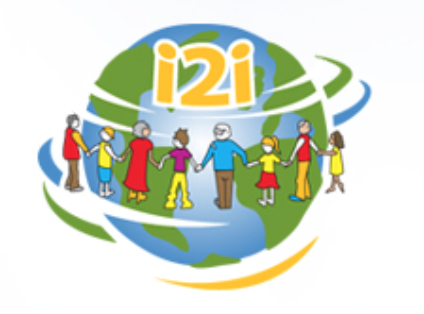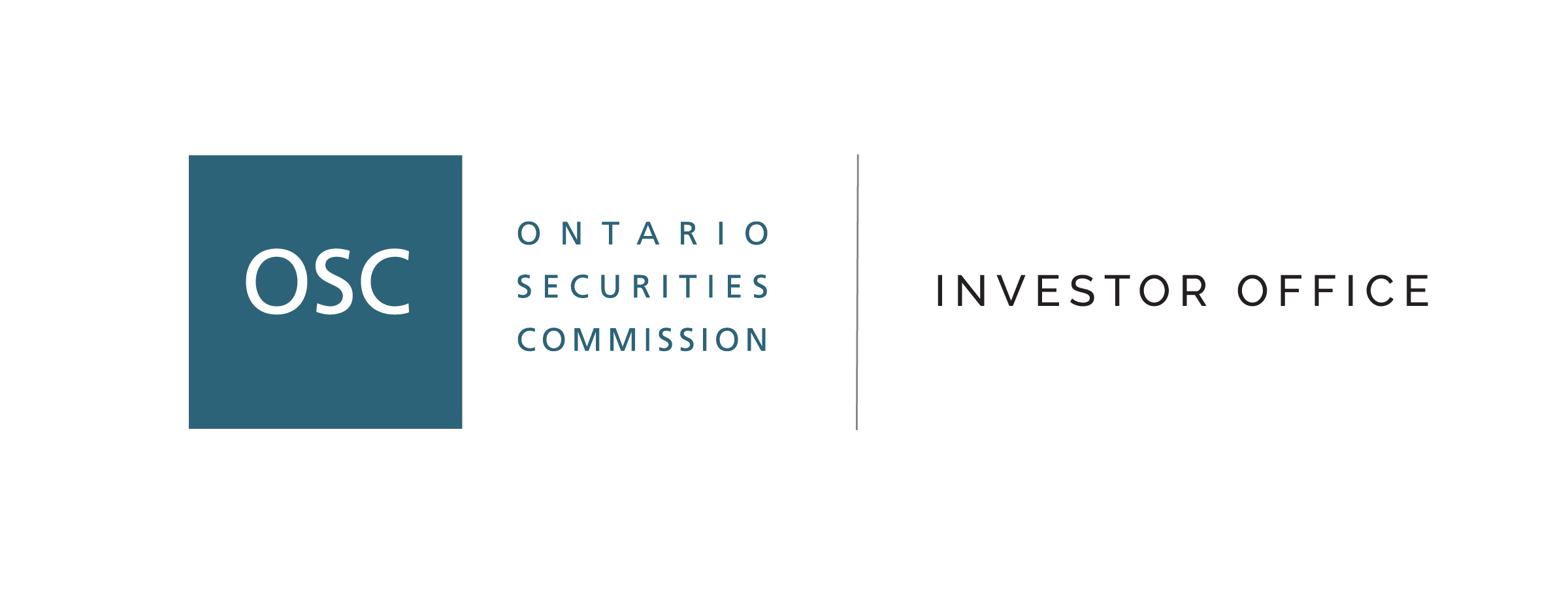- Details
- Published: 03 June 2015
Article Index
The CNPEA and CHNET-Works recently hosted a webinar on using social media to support your practice.
Your engagement and expectations were high and by the end of the webinar there was still much left to discuss. Here is a brief overview of the presentation, as well as a few guidelines to tackle socia media and a Q&A of all the questions that we did not have time to answer on the spot.
First a quick recap...
What social media isn't:
- dark magic
- "rocket surgery"
- Strictly a waste of time filled with cat videos
What social media is:
- a way to expand your audience and your horizons
- a personalizable source of information and a channel to peers and influencers
- composed of humans just like you, who are looking for ways to connect, to exchange information and to effect a change
Where to start?
- Review and define
- Conduct a quick assessment of your organization's social media presence. You may already have a few dormant accounts, waiting to be rediscovered and maintained. Gather all the logins and administrator privileges, update the email addresses tied to the accounts if needed, identify who the person(s) in charge of them will be.
- Identify your message and your goal(s).
- Agree on a strategy, a tone, a policy. Make sure your strategy aligns with your mission.
- Identify your target audience. Who are they? What do they use? What do they want to hear about? Start reading and listening to what they are saying.
- Don't spread yourself thin trying to be everywhere. Figure out which tool you are most comfortable with (text, images, sound etc) and pick the appropriate one. Stick to one or two social channels if you have a small team.
-Set SMART goals for your social media presence:
- Specific
- Measurable
- Attainable
- Relevant
- Time-bound
-5 key ways to engage as you get started:
- Listen & Participate - Get to know your stakeholders
- Storytelling - Engage the hearts and minds of your audience
- Knowledge Sharing - Leverage collective experience
- Community Building & Social Networking - Connect with peers and supporters
- Fundraising & Revenue Generation -Once you've established your community, ask for $
-Above all: start small and don't be afraid to make mistakes.
For more details on building a social media presence and strategy, here are the links to both webinar presentations in PDF format:
Lauren Bacon- The Social Web for Skeptics
Amy Juschka - Social Media for Social Good - Establishing the Framework to get started
The audio recording of the webinar is available here
TWITTER 101
While most of us are at least somewhat familiar with Facebook, at least on a personal level, Twitter remains a little bit more challenging to most.
Before you become a social media superstar, the first steps may seem daunting.
Here is a brief overview of what you need to do to get started.
Step 1
If you have decided to give Twitter a try, your first step will be to create an account.
It is an easy process, Twitter even offers the option of a tailored Twitter feed (i.e. your "front page news") based on your recent website visits. This will help streamline your newsfeed and select relevant sources of information for you. (This option is right on the signup page)
Step 2
Once you have opened an account, make sure to build an attractive profile. An appealing page can do wonders for attracting followers.
As soon as possible make sure that you add:
- a short, catchy summary introducing who you are/your organization is
- a link to your website.
- a profile photo/logo (depending whether you are doing this for yourself or your organization)
- a banner. Once again, if you are tweeting for your organization, use promotional material in jpeg format (a banner announcing your next event, themes/colours defining your brand/organization etc.)
- say something! 140 characters elevator pitch: Who are you? What are your values? Why are you here? etc.
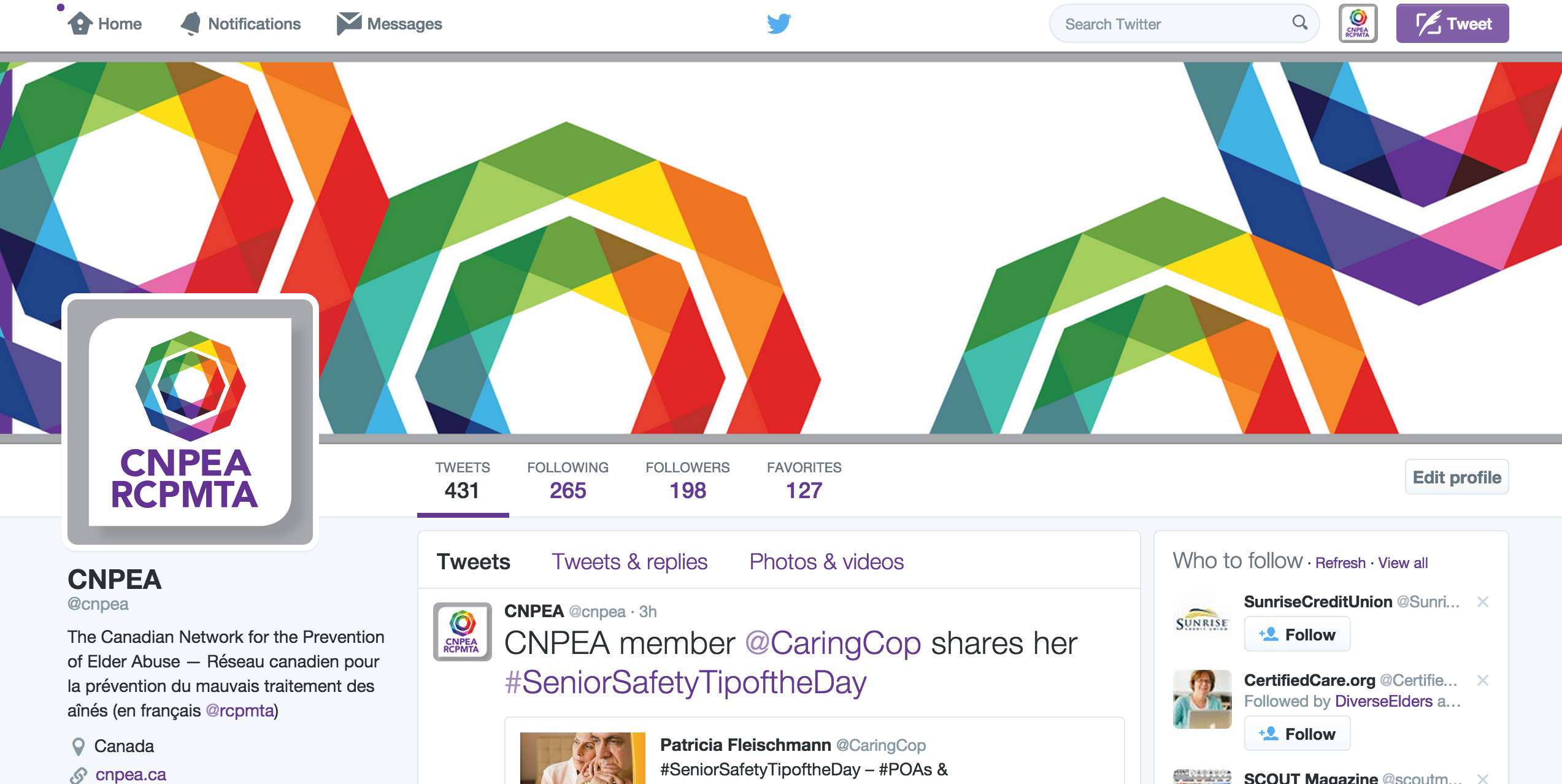
Step 3
Now, start building your contacts!
Look for people and organizations that you want to follow (this is how you will see their regular updates) and be followed by (so they can see your updates).
Start with your own personal contacts and direct collaborators.
Suggested accounts
Here is a list of accounts you may want to follow.
As you start following people, Twitter will make your life easier by recommending similar accounts, based on your contact list and interests.
Elder Abuse Prevention:
1-National Center on Elder Abuse
@NCEAatUSC
The NCEA also has a great blog which is tied to WEAAD and to their weekly Twitterchat themes (#WEAADWeekly).
2- Elder Abuse Ontario - @ElderAbuseOnt
3- Neighbours, Friends and Families - @NFFOntario
4- Mary Twomey - @ragingaging
5-Ageless Alliance - @AgelessAlliance
6-National Initiative for the Care of the Elderly (NICE) - @NICElderly
7-International Federation on Ageing - @IntFedAgeing
8- Patricia Fleischmann - @caringcop - A CNPEA member, Patricia offers insights on elder abuse from the law enforcement perspective. Keep an eye out for her #seniorsafetytipoftheday
9- I2i Intergenerational Society - @i2isociety
10- CCEL - Krista James - @CCElderLaw - CNPEA project coordinator and National Director of the Canadian Centre for Elder Law
11- Human Rights Canada - @CdnHumanRights
12- CNPEA - @cnpea
Social Media and Communications
13-HOOTSUITE - @Hootsuite
This Canadian social content management system offers tips on how to build a social media strategy and how to use the right tools via easy articles, infograpics, case studies etc.
Here is some suggested reading to get you started:
- 9 reasons why you are not getting more Twitter Followers
- How to Create a Social Media Marketing Plan or
- 5 things to do during your first week as Social Media Manager
14-Huffington Post 50 - @huffpost50
No need to introduce this media giant anymore. Huffington Post 50 gathers news and blogs on topics of interest to the 50+ , giving you instant access to a wealth of additional resources to be enjoyed and shared.
15- Lauren Bacon - @LaurenBacon
Our very own webinar co-presenter. Follow Lauren for more insights on social media, tech-savviness and leadership
Step 4
When it comes to developing your contacts, here are a few things you can do:
- browse through the contacts of the accounts you already follow.
- take Twitter’s recommendations (« Who to follow » on the right hand side of your homepage).
- import your email contacts to see who is already out there.
- Have you heard of an interesting organization or met someone new? Make a habit to look them up on Twitter and follow them. Most organizations will display links to their social media accounts on their websites.
Remember, this is a social, networking activity, not a test or a popularity contest.
Situate yourself/your organization :
- Which community(/ies) do you belong to or do you interact with on a regular basis?
- Who do you want to get updates from regularly ?
- Which ones can help you get your word out?
- Who do you want to reach, who is your target audience?
Strike a balance between peers and influencers (leaders of your field with an established following). You do not need to jump in the fray instantly. Listen to what they are saying, read some of the links and articles they share, retweet as a first participatory step.
Practice makes perfect. This will take some practice and a few trials and errors.
Your first steps may take more than 10mins a day. Brainstorm with your colleagues, someone on your team may be able to help you open your account if you are too busy.
Once these first steps are taken, a daily check or two (5mins in the morning, 5mins after lunch), can
- give you a brief overview of what your community is talking about,
- highlight relevant resources and events
- inspire you with new ideas for your own content.
Need more help?
- A quick Google search will provide many guides on the nitty-gritty of Twitter use and etiquette.
- Before they offered social media advice via their blog, Hootsuite created a dashboard to help organizations with several social media accounts manage their content.
If your organization has many accounts to monitor, a platform like Hootsuite (there are others out there too), will help you gather them all in one place and get a clear overview of all your interactions and activities. The basic version is free and well worth a try. - Feel free to explore the @cnpea account. Use our contact list, reach out to us directly, retweet or favourite our content. Our account is meant to be a resource hub and a springboard for other members of the elder abuse prevention community. Don't be shy, we will be happy to chat with you.
REMEMBER:
Starting on a brand new medium and becoming the spokesperson for an organization (even unofficially) can be scary. It gets a lot easier if you stick to the 3Ps principle:
Keep it Positive, Polite and Professional.
Happy Tweeting!
Q&A
Here are the questions harvested during the webinar. We hope that these will set you on the right path to social networking.
Question: Do you have a draft social media policy that you can share?
(several other questions had to do with matters of unpredictability / transparency / accountability and are gathered here for simplicity)
Social media policies will vary depending on the nature of your organization, its structure, its mission, the amount of people dealing with social media and many other factors.
Here are a few points that generally apply to everyone:
- Sharing and collaborating are at the heart of social media. Make them the building block of your policy: gather all team members who are active on social media to help shape the guidelines.
- Clearly identify the person or persons who will have access to your organizations social media accounts.
- Aways respect privacy and copyrights.
- Remain neutral
- Always respond to comments, whether positive or negative.
- In case of negative feedback, remain courteous, proactive and constructive i.e exercise the same common sense that you would in a "real life" situation.
Socialbrite offers very useful guidelines for non profits, educators etc. on creating a social media policy:
http://www.socialbrite.org/2013/02/05/create-a-social-media-policy-for-your-nonprofit/
Question: How can you prevent your social media use on sensitive/complex topics from becoming vacuous or leading to overly simple messages?
Answer: Character-sensitive platforms do not appear to leave much room for nuance, but each social channel offers different options.
You will be able to submit much more content on a channel like Facebook or LinkedIn than you would on Twitter.
Twitter is a brief expression of a moment or an idea and allows you to share links to more in-depth pieces. See it as a headline to grab the readers' attention and get them to read your full article, blog etc. It is an exercise in conciseness to get to the heart of what you want to share.
Thankfully, many of your peers are likely already doing this quite well. Keep an eye on what they do, retweet them, and find inspiration in their style.
Question: WEAAD is coming up. What and why would I tweet?
Why tweet? For the same reason that you would advertise or call friends to tell them about WEAAD.
You will reach more people and share your knowledge with a wider group of individuals through popular social channels.
What can you tweet? Activate your network and become each other's champions: announce the events that you are planning, talk about other partners' activities.
Let people know where they can find WEAAD activities and material.
If you are organizing an event, take photos and document the event as it unfolds.
Question: Creating your own 'community' was sort of discouraged, but that is our organization's only option, because there is no solid network wherein we fit. Any quick tips about that?
Creating your own community may take more effort and time than are available to you currently. Chances are similar groups already exist online. Are your organization's activities related to healthcare? research? law-enforcement? social work? academia? Maybe they are connected to several fields? Reach out to other organizations in these fields first.
If you have any doubt, start with bigger networks, like the CNPEA, whose mandate is to gather individuals and organizations from across Canada to build a national community of practice. Our members and supporters come from all walks of life and have much to share. Contact us directly by email or use our social media as a gateway to a wider net of contacts to share your activities and programs with.
If you are giving Twitter a go, search hashtags like #elderabuse #elderlaw #seniors #WEAAD #WEAADweekly. Each of these gathers all tweets relating to these themes.
#WEAADweekly is a weekly Friday chat. The organizer, The National Center on Elder Abuse (@NCEAatUSC) will announce a new theme each week until WEAAD and will invite insightful stakeholders to take part in the conversation. You could easily join in, it is a good way to get inspired, gain exposure and interact with other peers through an easy Q&A format.
Get in touch with us
You can inquire further about how the CNPEA can help you get your word out by email, or find us on Facebook and Twitter.





